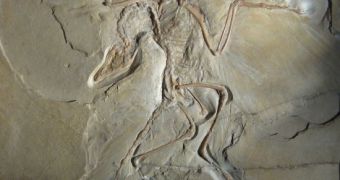Studies of fossilized feathers revealed that the earliest ancestors of modern birds could not readily flap their wings and soar to the air. The research showed that, while the wings themselves were indeed developed, and ready to take the creatures to the skies, the feathers were far from ready to generate enough lift. The delicate plumage was still very weak, a new investigation on two ancient bird species revealed. The feathers had very thin shaft, and they most likely did not allow for the type of flight we see today in modern species, Wired reports.
Scientists Robert Nudds and Gareth Dyke recently published the results of their engineering analysis on the feathers in the May 14 issue of the esteemed publication Science. Nudds is an evolutionary biologist at the University of Manchester, in England, while Dyke holds an appointment as a paleontologist at the University College Dublin. Their work shows that the two species they studied, the famous Archaeopteryx and the less-known Confuciusornis, had feathers which could not withstand the demands of sharp aerial maneuvers, or even stronger flapping. As such, the creatures were most confined to using their plumage for gliding from one tree to the other, or to the ground.
The team also says that the birds were at a high risk of buckling or snapping their feathers if they attempted any “fancy” maneuvers. For the purpose of this study, the two applied measurement techniques generally employed to gage the load-bearing capacities of bridges and beans to ancient feathers. Data on these were collected from fossils the team had access to. They then compared their results with information obtained from the analysis of feathers from modern birds, including pigeons, gulls, albatrosses and vultures.
“Even if these feathers had solid shafts, they’re not very impressive. They’re so flimsy that they couldn’t have supported much weight,” explains Ohio University in Athens paleontologist Lawrence Witmer. He was not directly involved in the new investigation. “Not only is the shoulder joint oriented wrong for powered flight in Archaeopteryx and Confuciusornis, but the new study shows that even the feathers aren’t built right for it. I’ve thought for some time that the feathers of nonavian dinosaurs and [primitive] birds were primarily display structures, and the lack of powered flying ability is consistent with that idea,” concludes Fayetteville State University paleontologist Phil Senter.

 14 DAY TRIAL //
14 DAY TRIAL //